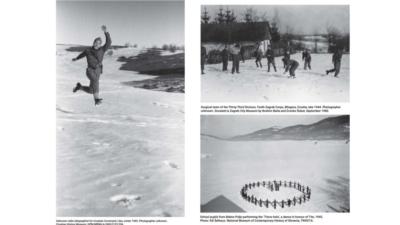Snow 1
“The magic of the Plitvice Lakes bound by snow and ice was breathtaking,” Eva Grlić wrote in her memoir. She explained: “The landscape seemed like the enchanted, glittering courts of the Snow Queen. The waterfalls turned into the organ of icicles while the blue water could be seen under the ice. People crossed the frozen lakes with sleighs and horses. It was silent and beautiful as if there was no war. We found only members of the English military mission sightseeing. Nature did not recognize human adventures at all, it was and remains as majestic and inexorable as fate.”
Precisely the winters abounding in snow and ice proved to be inexorable for the Partisans to the greatest extent. Then the footprints threatened to reveal the routes they used and the locations of their bases. Its brightness revealed figures at great distances. And because of exposure to extreme weather conditions – particularly during long marches – the Partisans suffered serious health consequences, at times with fatal outcomes. A good example is certainly the case of the Slovenian dancer Marta Paulin – Brina (https://www.cmi.no/resource/1592-brina), who could no longer dance due to frostbite she suffered in the winter of 1944.
At the same time, the snowy weather could also provide an opportunity for children’s play even among adults. And, as the photo of the children in the circle testifies, in some cases children’s games were used as a testimony to the resistance of the entire community. Under the guidance of their teacher, the same children drew a five-pointed star and the name of the leader of the armed resistance, Tito, in the snow, both unifying symbols of the People’s Liberation Struggle.

Images: Davor Konjikušić, Red Glow: Yugoslav Partisan Photography, 1941-1945 (Berlin and Boston: Deutscher Kunstverlag, 2021), 224, 226, 229, 231.
Quote: Eva Grlić, Sjećanja [Memories] (Durieux: Zagreb, 1997), 108.
Further reading:
Kirn, Gal. “Was Dancing Possible during the Fascist Occupation of Yugoslavia?” Apparatus 11 (2020): 1-12. https://doi.org/10.17892/app.2020.00011.238.
